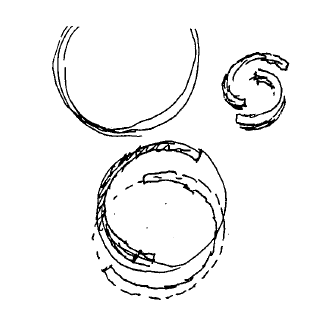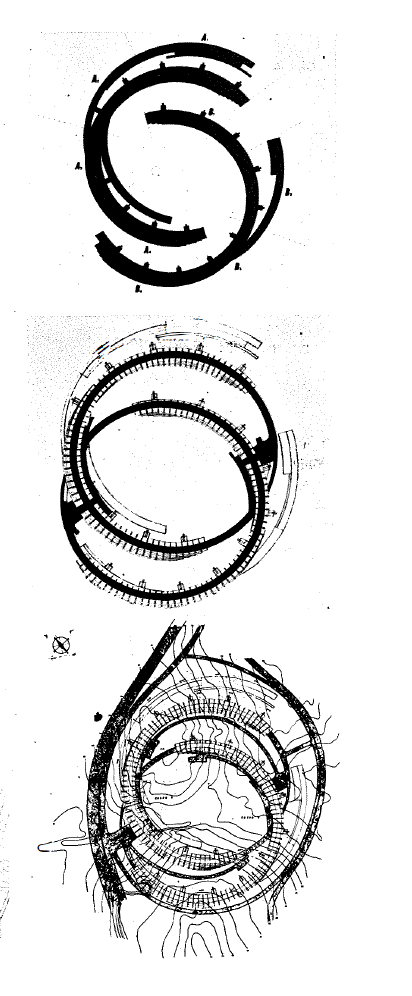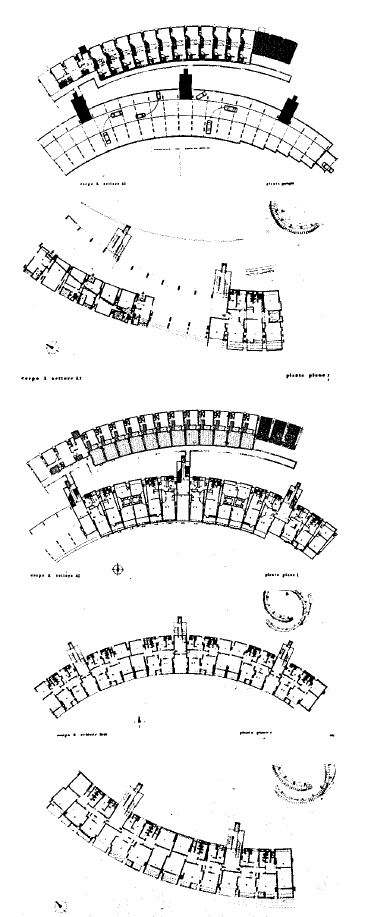Category: Perugini Projects
In 1955 Perugini worked on a project to reconstruct a village destroyed by an earthquake. This project can be seen as an incubator for ideas later realised in the Casa Sperimentale.
Instead of a plain reconstruction of the town Perugini suggested to leave the destroyed buildings and create a new structure out of trellis beams and inhabitable cubes suspended above the old town.
A modular system would have allowed the different cubes to be combined to respond to different needs for inhabitation- echoing the memories o the lost buildings below.
Still working compositionally with traditional methods like the Golden Section, Perugini saw the design as dynamic structure as a response to the destructive tensions created by the earthquake.
Built out of concrete all elements – the building and the furniture were cast out of the same material.
Cuts in the walls would have allowed light to enter the structure very much in the same way Giuseppe suggested the window slits in the early versions of the design for the Casa Sperimentale. San Germano, in Perugini G., Progetti e Ricerca, p. 38-41
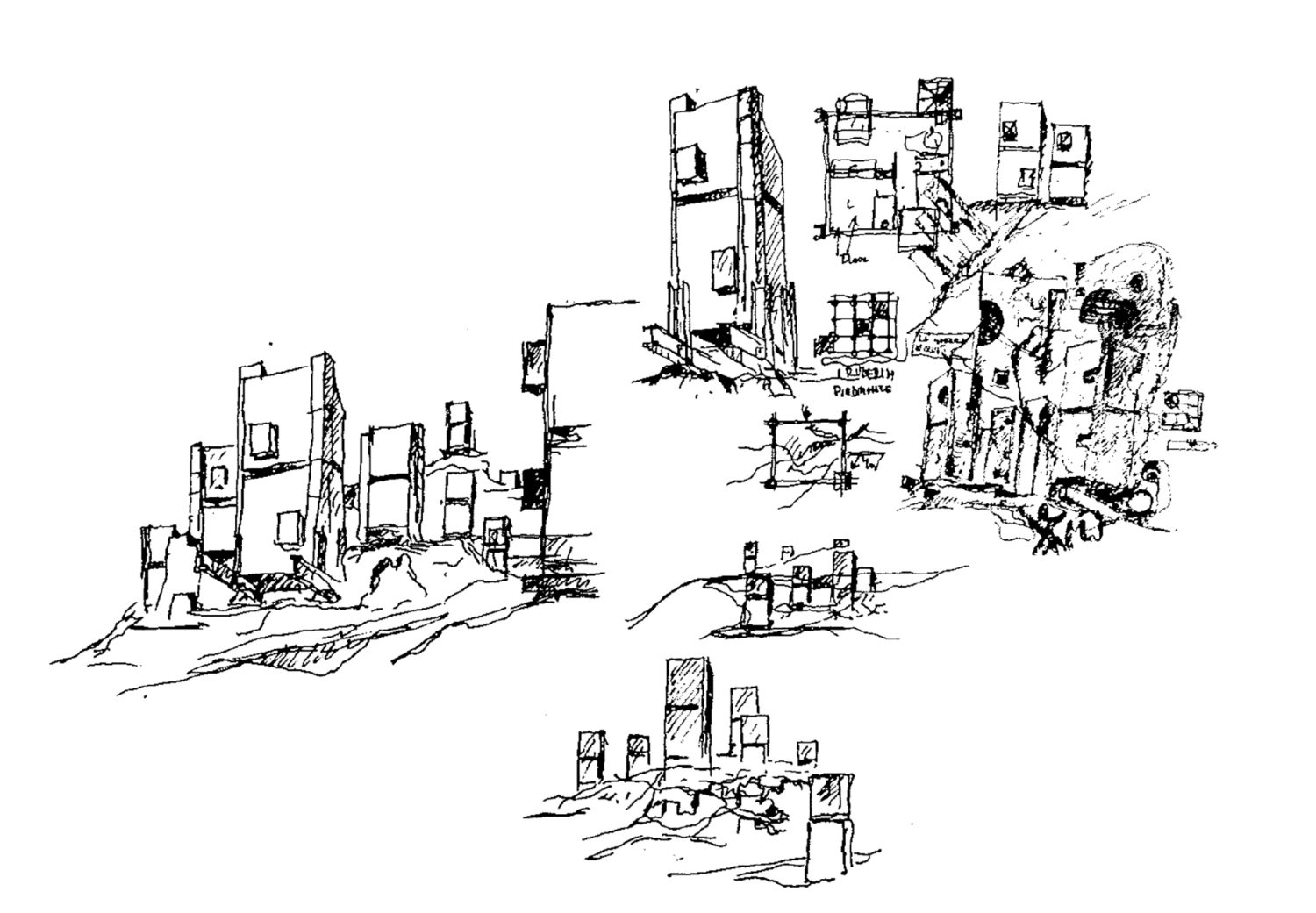
Early sketch showing the idea of the suspended cubes off the concrete mainframes.
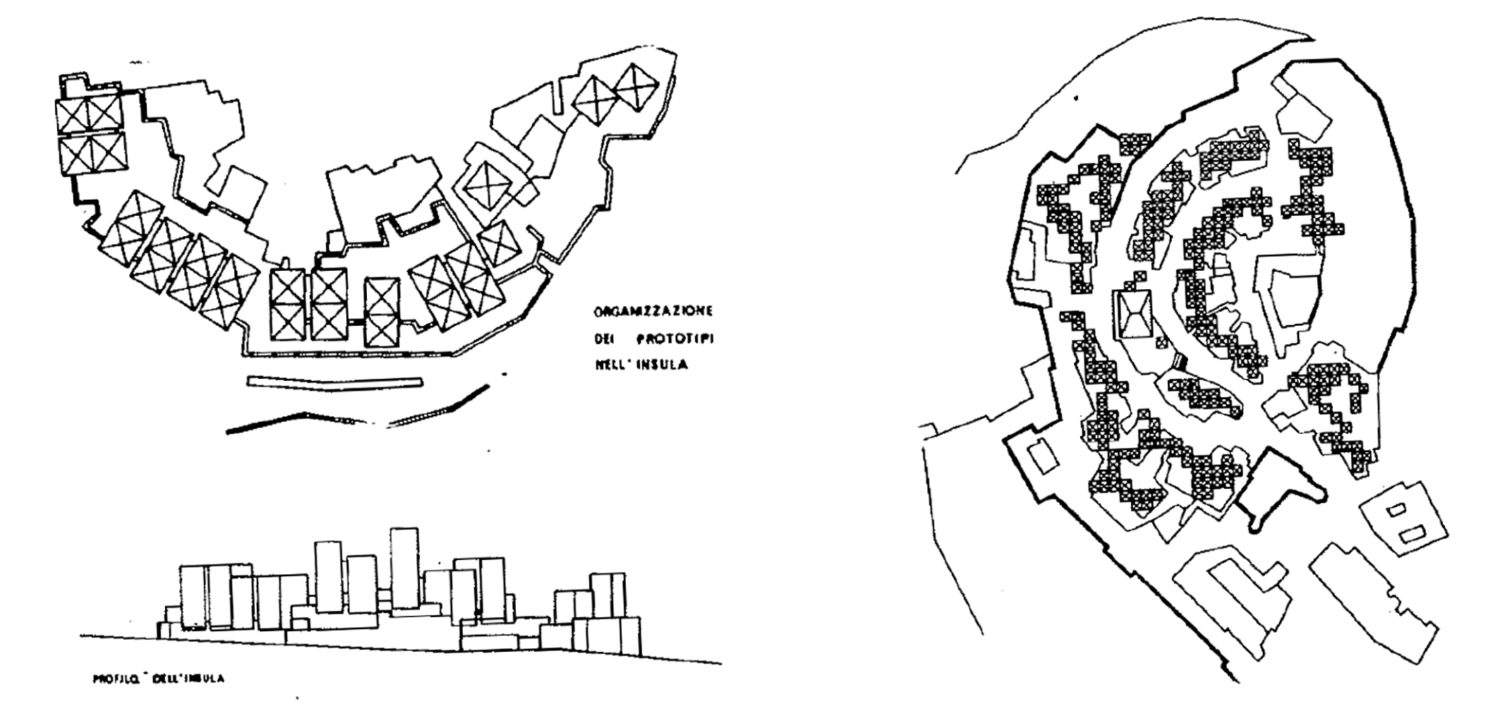
Site plan exploring the layout of the added cube inhabitations above the ruins of the town.
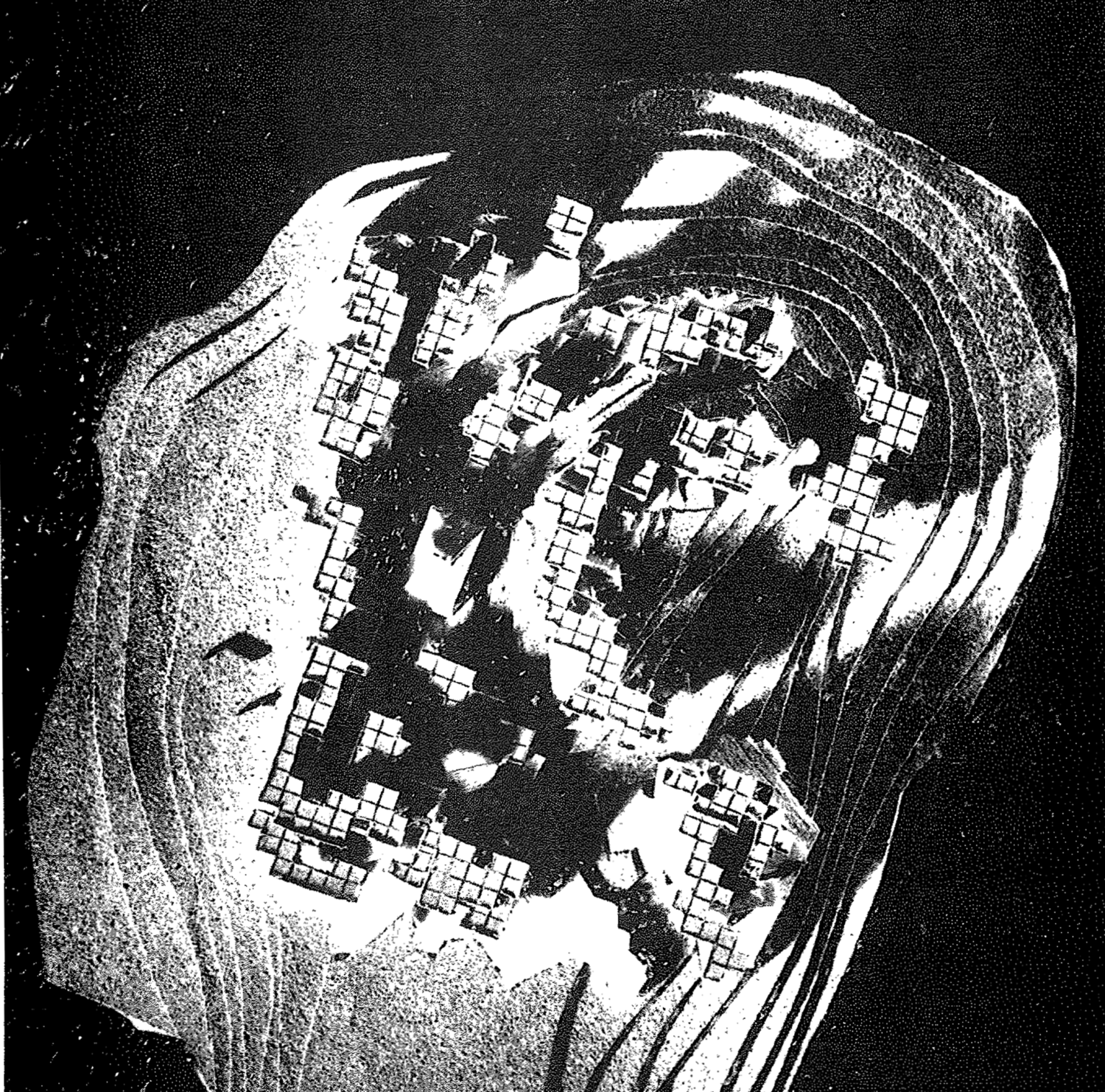
Model image of the competition entry.
CompetitionCompetition Fortezza da Basso, National Centre for Arts and Crafts, Florence, Italy (1967)
Perugini himself describes the project as:
‘The Fortezza da Basso has a definitive and objective aspect: “it is a prototype of functionality and formal quality” and not a container to be filled with other objects.
Starting from this objective vision of reality, the project focuses on an anti-object solution or rather on visualization. One of the formative process of the object itself.‘ Perugini G., Progetti e Ricera, p. 97
Perugini saw the design not just as yet another exhibition design or like many others an empty shed to be filled with the exhibits. He envisioned a space that is three-dimensionally dynamic, able to respond, being recombined to facilitate a variety of functions. The movable elements were meant to respond to different requirements of space. They were controlled by an electronic brain that controlled the sliding and turning elements and moved them with electromagnetic plates.
These ideas have been heavily influenced by Perugini’s own research and interest in a cybernetic architecture, one that can be controlled by a central computer. These ideas reoccur in both the Cybernetic Hospital 1967and the Vienna Competition.



1948
Project of a “Vienna” club in via dei due Macelli, Rome.
1949-1950
API – Gas station AGIP in via Albano, Rome
1950
Villaggio Mommorosa -centro insediativo per sfollati di guerra, Cecina (Toscana)
API – Stazione di servizio, piazza Albania a Roma, Rome
Competition for an auditorium in Naples, Naples
1950-1951
Building typology (shops and apartments) Empoli
Istituto case popolari di Empoli Gestione Ina-Casa
Six Townhouses, Vinci, Vinci (FI)
Istituto case popolari di Empoli Gestione Ina-Casa
Four houses in a village, Vinci Spicchio, Vinci Spicchio (FI)
Istituto case popolari di Empoli Gestione Ina-Casa
Four houses , Montelupo, Montelupo (FI)
Istituto case popolari di Empoli Gestione Ina-Casa
Building, Volterranea, Montespertoli (FI)
Istituto case popolari di Empoli Gestione Ina-Casa
Building, Cerreto Guidi (FI)
Ina-Casa
Building, Certaldo, (FI)
Istituto case popolari di Empoli Gestione Ina-Casa
Building, Castelfiorentino (FI)
Ina-Casa
Building, Colle San Magno (FR)
Ina-Casa
Building, Colle Val D’Elsa (SI)
Ina-Casa
Concorso per il progetto di massima di edifici Ina-Casa in esecuzione del piano incremento occupazione operaia (II anno), Avellino
Ina-Casa
Building, Fucecchio (FI)
Ina-Casa
Building Lastra a Signa (FI)
Ina-Casa
Four houses in Lastra a Signa (FI)
Ina-Casa
Nucleo 5 alloggi nel quartiere Punta di Francia, San Remo
Ina-Casa
Nucleo 7 alloggi in via G. Borea, San Remo
Ina-Casa
Progetto per 8 alloggi, San Remo
Ina-Casa
Building, Arenzano (GE)
Istituto case popolari Genova (Icp Genova)
Edifici posti in via S. Sebastiano e via Cadorna, Rossiglione (GE)
Istituto case popolari Genova (Icp Genova)
Building in Borzonasca (GE)
Istituto case popolari Genova (Icp Genova)
Studio per 8 alloggi da costruirsi nella frazione Cortina Grava (BL)
Istituto case popolari Belluno (Icp Belluno)
Case a schiera: 8 alloggi, Cortina d’Ampezzo (BL)
Istituto case popolari Belluno (Icp Belluno)
Nucleo di 6 alloggi su tre piani, Civitella del Tronto (TE)
S.A.Inps Roma-Gestione Ina-Casa
Nucleo di 3 alloggi su due piani nella frazione Ville Lempa nel comune di Civitella del Tronto (TE)
Ina-Casa
Building Mazzano Romano (RM)
Ina-Casa
Building Anguillara Sabazia (RM)
Ina-Casa
Eight row houses, Cortina d’Ampezzo (BL)
Istituto case popolari Belluno (Icp Belluno)
1951
Buildings in a village in the Comune di Cerreto Guidi (FI)
Istituto case popolari di Empoli Gestione Ina-Casa
1952-1953
National competition for the API service station
Tre fontane e strada 34, Rome
1953-1963
Primary school Villalba Montecelio nel comune di Guidonia (RM)
1954
Study for a church
Project of the parish church, Petacciato (CB)
Sewage and water works, Petacciato (CB)
1955
Reconstruction plan Piedimonte San Germano, (FR)
Amministrazione di Piedimone San Germano
1956
Competition for the Fermi Memorial, Chicago, USA
With C. Parolini, T. Valle
Church, Piedimonte s. Germano (FR)
Invited competition for the Italian Pavilion at the Expo1958 in Bruxelles, Belgium
With BBPR, I. Gardella, L. Quaroni e A. De Carlo
1956-1959
Buildings for the Ina Casa district, Rome
With E. Del Debbio, U. de Plaisant, F. Dinelli e F. Girardi
Ina-Casa
1957
National competition for the Palace of Justice, Bari
1958-1961
Hotel Raphael: restoration and renovation, Rome
1959-1962
National competition for the judicial city of Rome.
With V. De Feo, U. de Plaisant, M. Nicoletti, E. Giangreco e N. Monteduro
1960
API – Service station
With E. Del Debbio, U. de Plaisant, F. Dinelli e F. Girardi
Ina-Casa
Progetto ” Service station”
API – Service station in via Palombella, Ancona
API – Renovation of offices in corso Italia, Ancona
API – Cooperativa in via Asmara, Roma
API- Service station Agip, Pesaro
API – Intervention on existing building, Viterbo
API – Service station in via Casilina, Roma
API – Service station, Terni
API – Service station, Avezzano
API – Service station, Foligno (PG)
API – chioschi. Chiosco a Napoli; chiosco all’Eur, Roma; progetto di un chiosco in via Aurelia, Roma; chiosco non identificato, Naples
API – Service station
Supermaket sulla Cristoforo Colombo, Rome
1961
Experimental building project,
With C. Ciribini, E. Giangreco, M. Parolini
1964-1965
Project for a church in the pine forest, Fregene, (RM)
With I. Ailardi
New housing development in the neighborhood Tre Fontane, Rome,
M. Fiorentino, O. Gargano, G. Vaccaro (project coordinator), T. Valle, consulenza generale: R. Neutra
Ministero del tesoro e Direzione generale istituti di previdenza
1964-1967
Service facility along the highway del Sole (area di servizio Fabro), Ancona
1965-1972
Residential building, Arcinazzo, (RM)
With R. Perugini
1966-1967
Casa Perugini, Fregene,
With U. de Plaisant e R. Perugini
1967
Competition for the exhibition set-up in the Fortezza di Basso, Firenze (FI)
Ente Mostra mercato internazionale dell’artigianato
Inarch-Finsider competition for experimentation in steel design,
With U. de Plaisant
1967-1979
Tratto autostradale Resuttano-Enna lungo l’autostrada Palermo-Catania
1967-1968
National competition for new ecclesiastical typologies: Chiesa nel quartiere Primavalle, Rome
With G. T. Tonelli
1967
Competition for the Unido headquarters, Vienna,
With U. de Plaisant
National competition for the new cybernetic hospital in the neighborhood Pietralata, Rome,
With U. de Plaisant, A. Tonelli, G. Tonelli
1968
National competition for the urban planning of the Caffarella Valley in Rome,
With A. Tonelli and G. Tonelli
1969
Service station, Milan
Provincia di Milano e AGIP
Delta hotel in via Labicana, Rome
With G. Tonelli
Bridge across the Strait di Messina,
With U. de Plaisant, V. de Benedetti, G. Mennocci
Competition, not completed, for the Palace of Justice, Naples,
1971
International competition for the multipurpose center of Plateau Beaubourg, Paris,
O.C. Cacoub, R. Heim de Balsac, G. G. de Rossi, R. Perugini, Y. Roa
1973
Partial restructuring and restoration project of compartment no. 34 between Corso Garibaldi
Corso Mazzini – piazza della Repubblica, Ancona
With A. Roccetti
1974-1975
Mosque in Rome,
C. Longo e A. Bouzira
1975
Competition for the business center: national competition for the planivolumetric design of a business area located in the Florentine territory within the central metropolitan area of Florence
With F. Malusardi, G. Bianchi, R. Bracci, R. Perugini
1976-1981
Contract-competition for the buildings of the Filippo Turati social housing consortium in the Laurentino area, RomeWith C. Chiarini, C. Michelangelo, S. Pasanise
1979-1982
Restoration of the seventeenth-century Muti-Bussi palace near Piazza Venezia, Rome
1983
International La Défense competition in Paris,
With R. Heim de Balsac, R. Perugini and others.
1983-1989
Restoration of the monumental complex of Villa Mondragone, Monteporzio Catone (RM)
1986
Competition for the executive design and contract of the new headquarters of the Cassa di Risparmio di Jesi (AN)
With R. Perugini, B. Begnotti, Rolletti
1987
International competition for the expansion of Turin Caselle airport, Torino
With G. Tonelli, R. Perugini
1987-1989
Redevelopment of the main stations in Verona
1987-1991
Renovation of the town hall, Celano (AQ)
With S. Nicoletti, P. Micalizzi, R. Perugini
1988
Proposal for the construction of an integrated shopping center in Le Torri a Cintola, Firenze
With Moreno Paolo Torri, P. Micalizzi, S. Nicoletti, R. Perugini
Outpatient clinic project and Local Health Unit 53, Corleone (PA)
With R. Perugini
Study – design of the structures of the railway junction, Verona
With G. Valle, R. Perugini
1989
Cultural centre, Forte dei Marmi, (LU)
1991
Monument for Natalino Sapegno,[Aosta]
Feasibility plan for the new university, Cassion (FR)
Master plan for Ciampino
With R. Perugini
Master plan for Racalmuto in the Agrigento area, Racalmuto (AG)
Master plan for Castelverde, (CR)
Master plan for Roma
Master plan for Castel Madama (RM)
Master plan for Macerata
No dates
Appartamenti Peretti, Ancona
Casa Arioni (arredo) in piazza Quiriti, Rome
Tangenziale, Arezzo
With R. Perugini
Competition for the Palace of Justice in the former Caproni building in the Borgo Pineta district, Avezzano
Competition of ideas for the design of an urban ring road, Arezzo
Project of reworking the elevations of the building of the società F. I. -Cattapirone
Extension Casa Janaki, Corfù
Extension Casa del sindaco, Celano
Restauration Casa Morricone all’Ara Coeli, Roma
Casa -albergo dell’onorevole (ristrutturazione), Perugia
Extension casa Di Geso, Ardea
Restauration Casa Sapegno in piazza del Gesù, Roma
Solunto
Villa dell’amico di Sergio Rossi, Albano laziale
Casa Teofili in viale Cassia, Roma
Casa Rizzi in viale Cassia, Roma
Casa Meniconi e Cerbello in via della Massimilla, Roma
Casa bifamiliare sulla provinciale Nettuno-Cisterna, Roma
House extension in via Appia antica, Roma
Casa Tonelli
Internal changes to the house of the director of the National Bank of Agriculture, Terni
Restauration Casa Padovani-Lemmi, Empoli
Competition for the Centocelle park in Rome
Church project, Petacciato
Casa for Donati Delio, Fregene
River cooperatives
G.B.R
With R. Perugini
Competition contract for the construction of a public residential building project in the Spinaceto district, Roma
Istituto autonomo per le case popolari (Iacp)
Project for the Cariplo headquarters, Jesi
Houses for workers in the Pegli district, Genova
Ina-Casa
Office redesign in via Milano, Bolzano
Competition contract (Navarra) for the extension of the regional headquarters, L’Aquila
Villa Gentile (ampliamento II Università), Rome
Fruit market
Renovation of a basement for public use
Duomo, Orvieto
Casa Padovani, Empoli
Restoration project of Casa Perugini in via della Dogana vecchia- 11, Roma
Renovation of a former farmhouse in piazza Martignana, Firenze
Casa P in via Traversari – 51, Roma
Teatro di Pirandello
Tabaccheria Reali: vetrina
Edilizia residenziale: alloggi, Rocca Santo Stefano (RM)
Studi of a tombe
Cappella Colognese
Cappella al Verano (Delle Monache?)
Cappella Lamberti, Calascibetta
Tomba romani
Cappella Salvatori
Cappella Savelli al Verano, Rome
Casa Cianci, Termoli
Pizzo, Termoli
Stazione di Termoli
Parco nel quartiere Trullo, Termoli
Piazza del Papa, Termoli
With R. Perugini
Master plan per Termoli
With R. Perugini
Fabbricato residenziale n. 3
Parco nel quartiere Trullo, Roma
[Progetto di palazzina], Viterbo
Project for the Università, Salerno
Università di Faenza (SA)
Unidentified project in the Fregene area -Maccarese )RM)
Survey dell’Aniacap
Angrisani: Ampliamento di un centro di recupero per handicappati
Project for a refreshment point, Terracina
Cartografia: Novara (Piano regolatore generale )
Cartografia (varie località): Milano, Maccarese, Bari
Raccolta di cartografie e piante catastali di Roma
Cartografia su Roma
Cartografia sulla Sicilia
Progetto per una sedia
Concorso per il Parlamento, [Roma]
Casa Borzi sul Gianicolo, Rome
Casa Cacchione
Ministero della guerra, [Rome
Camera dei deputati, Roma
Prato dei diamanti
Osaka
Ospedale, Empoli
Università della Calabria
Paride
Gerini
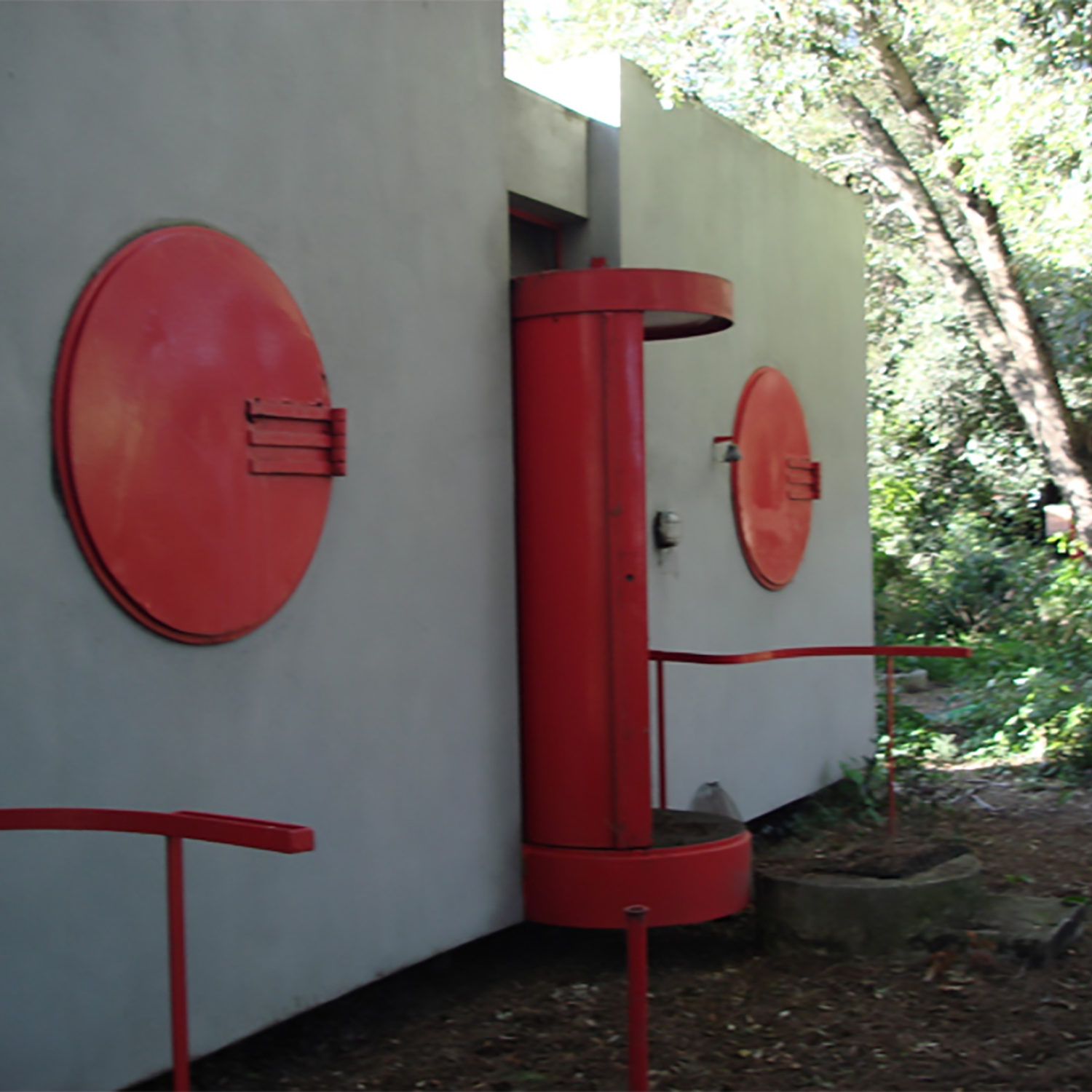
The Cabins, Cubetti set at the rear of the site are an entirly different concept of living. They are build out of traditional blockwork and rendered to fit with the rest of the ensamble of the buidlings.
The buildings consist of three cubes connected with an linking element that at the front has a tubular rotating door and at the back two separate bathrooms.
The rooms have circular windows with heavy metal hinged shutters.
The buildings had been locked for more than two decades and we were the first ones to open them up to start cataloging the interior. Inside are some of the saved furniture from the main house.

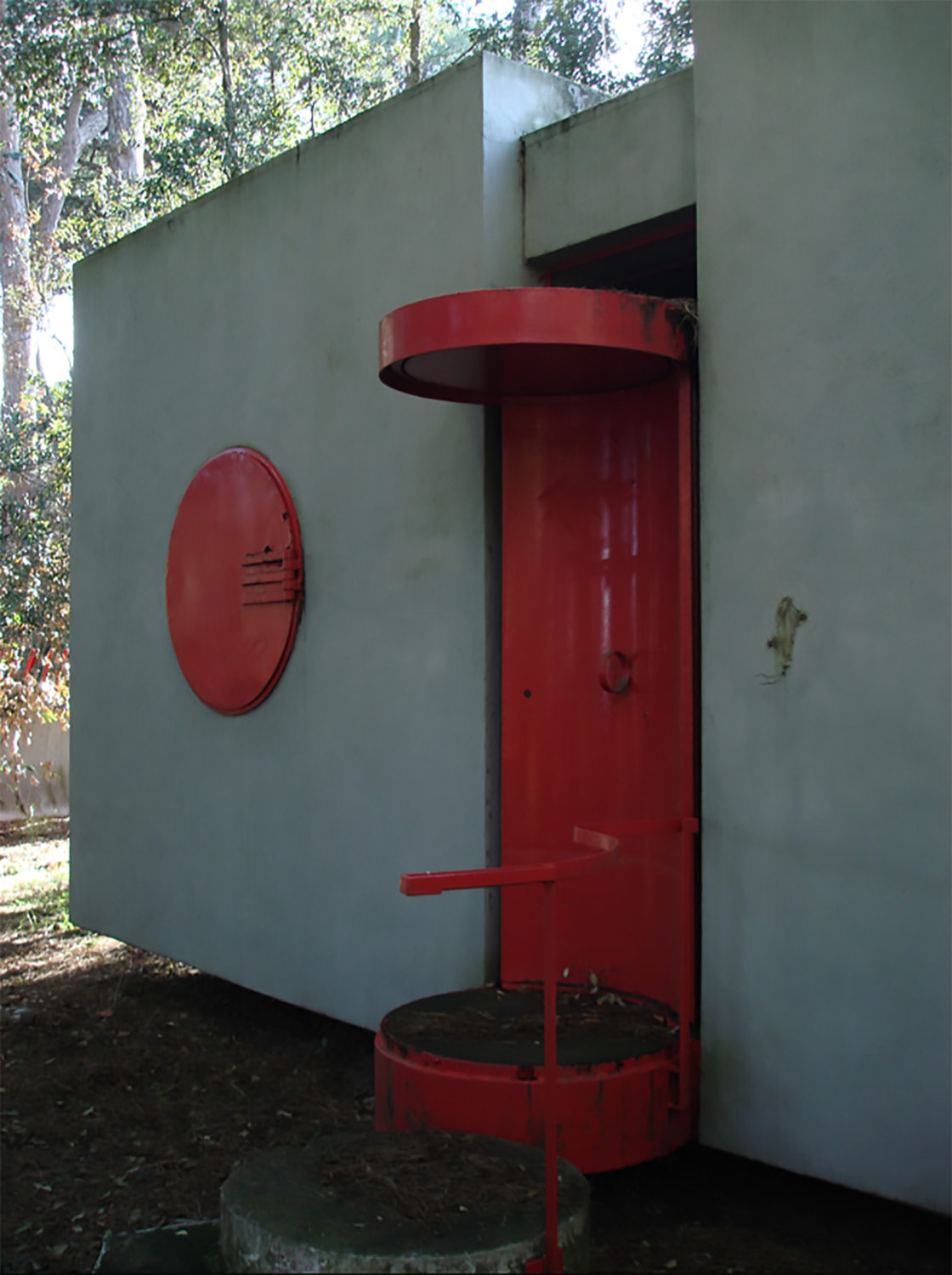
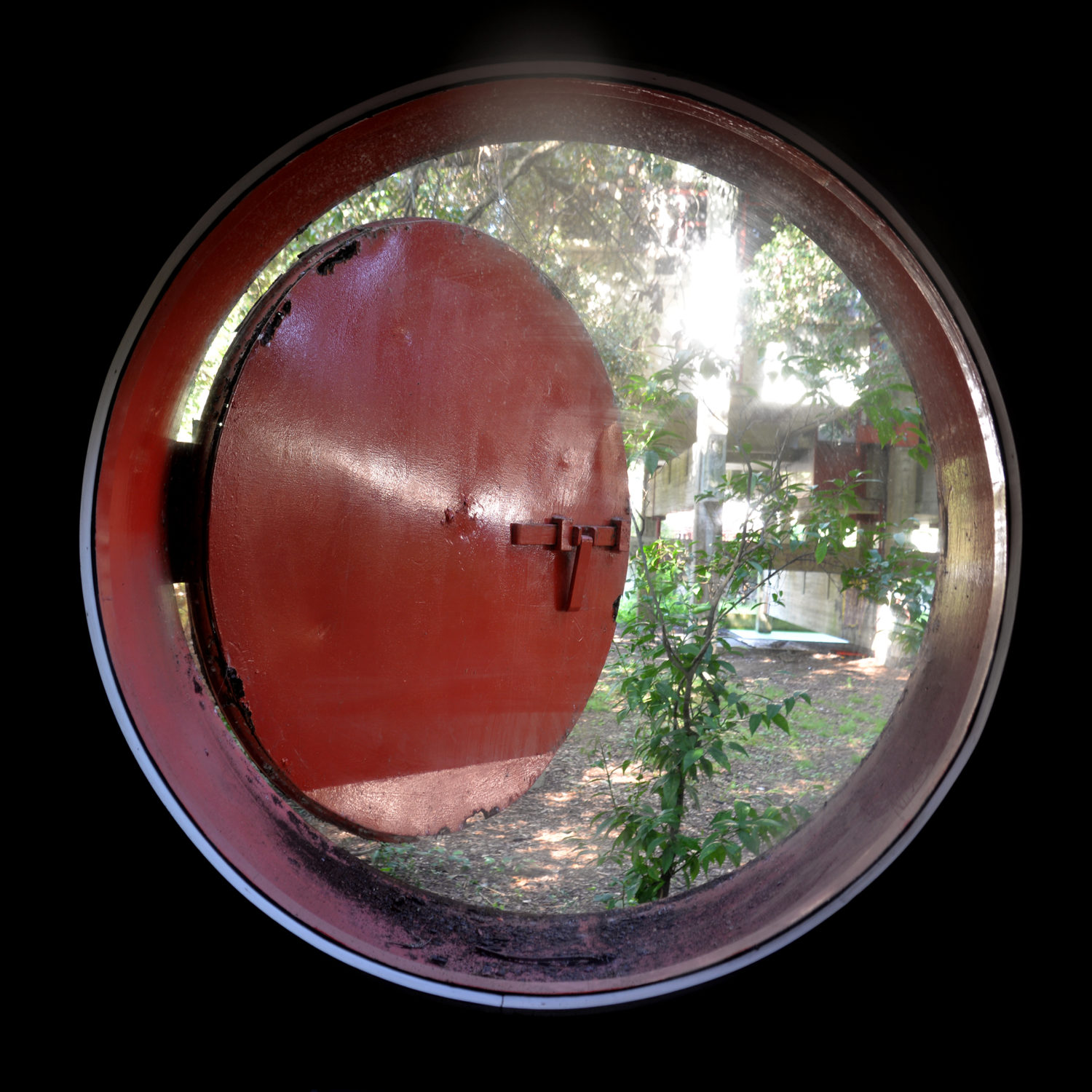
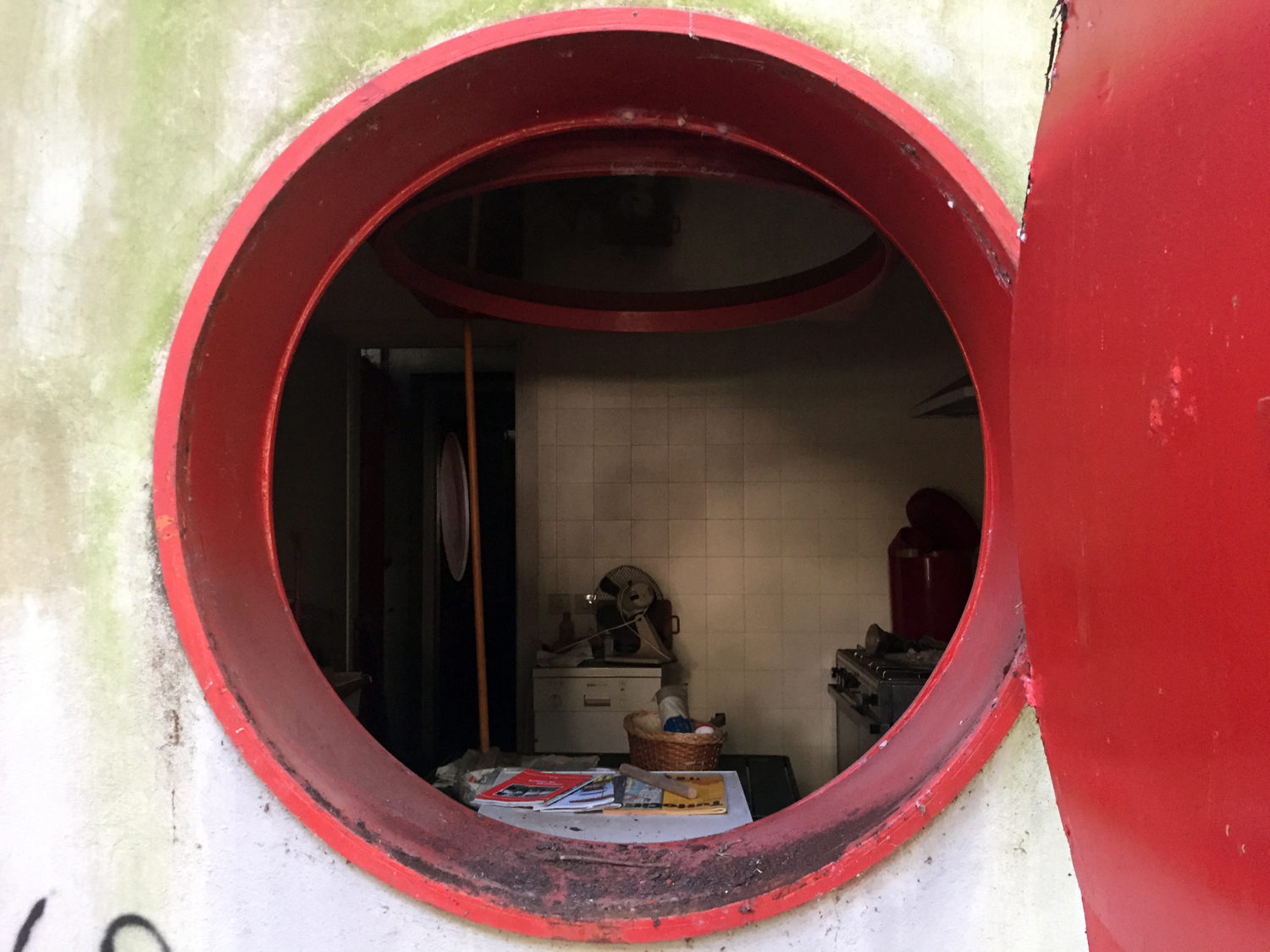
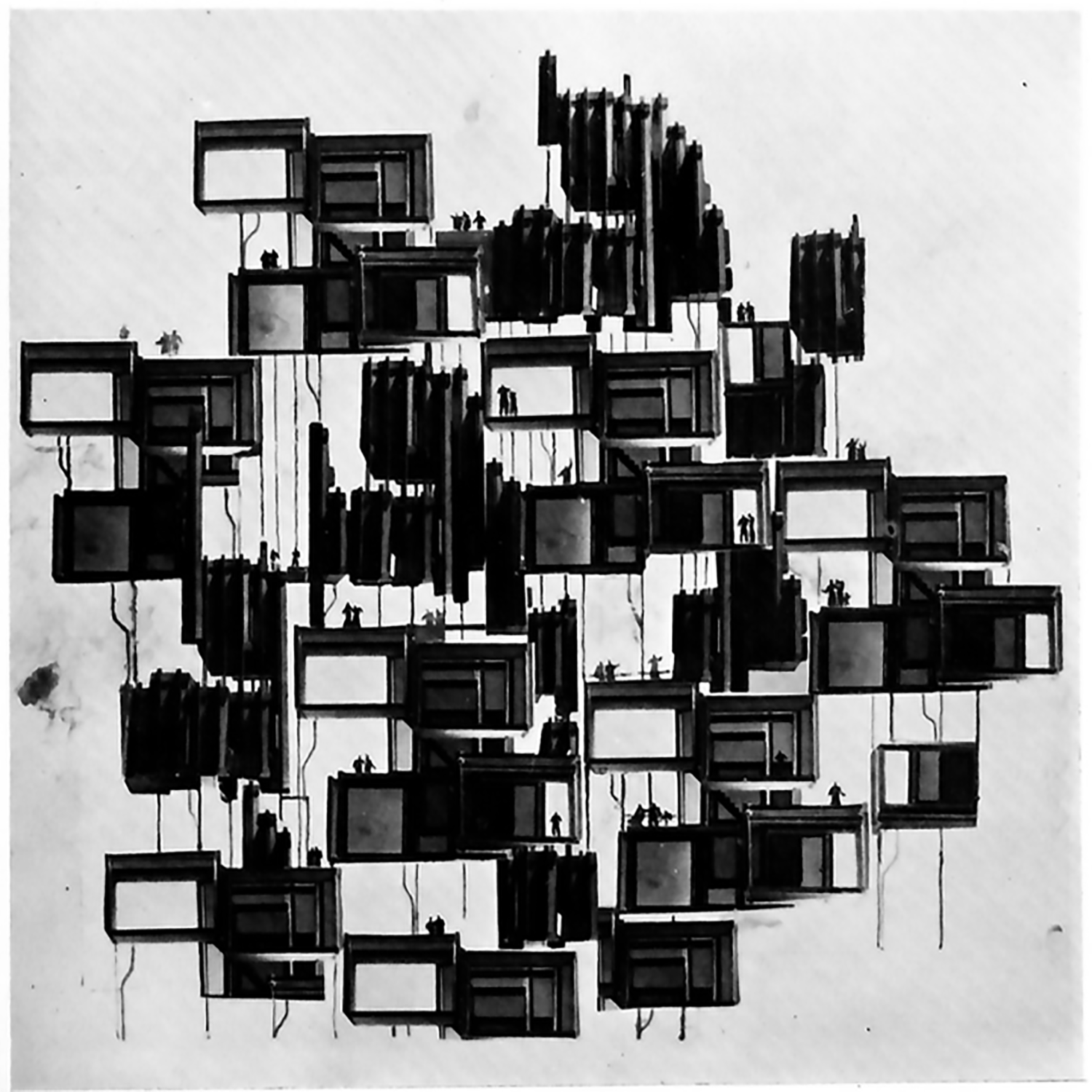
The winning entry for the Inarch Finsider Competition in 1967 can be seen as the prototype idea for the Casa Sperimentale.
Working with the ideas of a steel structure with suspended living and service elements in form of frames, Perugini envsioned the building elements to be mobile and reconfigurable. Each element is a basic frame fulfilling a basic function – an open space, a bathroom, a kitchen, a well segment etc. Each element had a thickness of 600mm with an element size of 2m, 4m, 3m and 4.8m. By combining different sized elements in a variety of positions and combinations it was possible to create an infinite numbder of possible inhabitatons.
Vaying the heights elements could have multiple functions—a floor, a bench, a table, etc.
Perugini was awarded the first prize for the “construction in the workshop of steel building types through the design of a living cell intended as a matrix of growing organisms”.
All elements were to be built in a workshop and delivered to site with all fixtures and fittings ready to be installed and inhabited.
The main space frame to support and hang the elements off were made of steel sections set into concrete foundations.
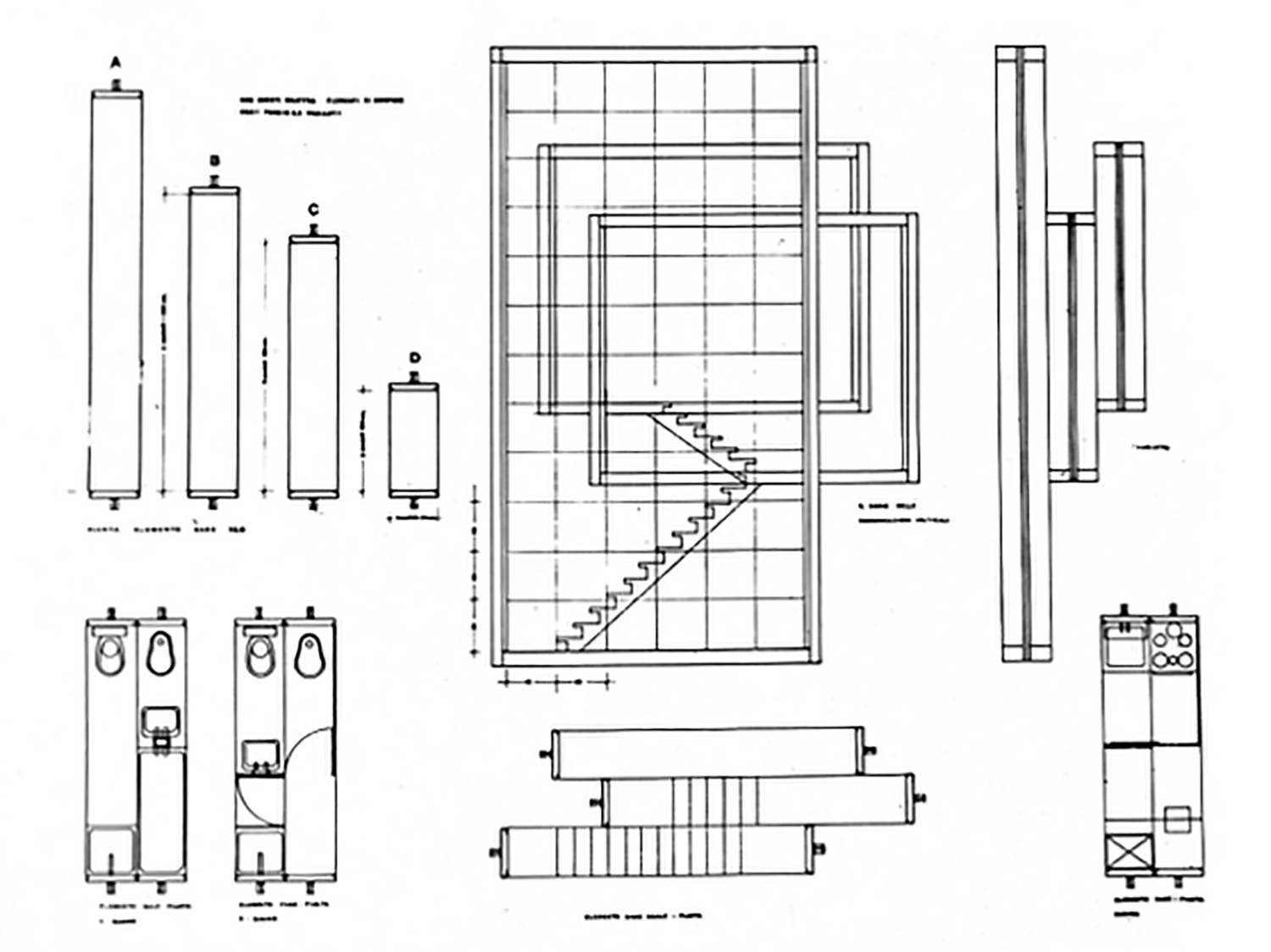
Drawing exploring the different elements and hteir possible combinations.
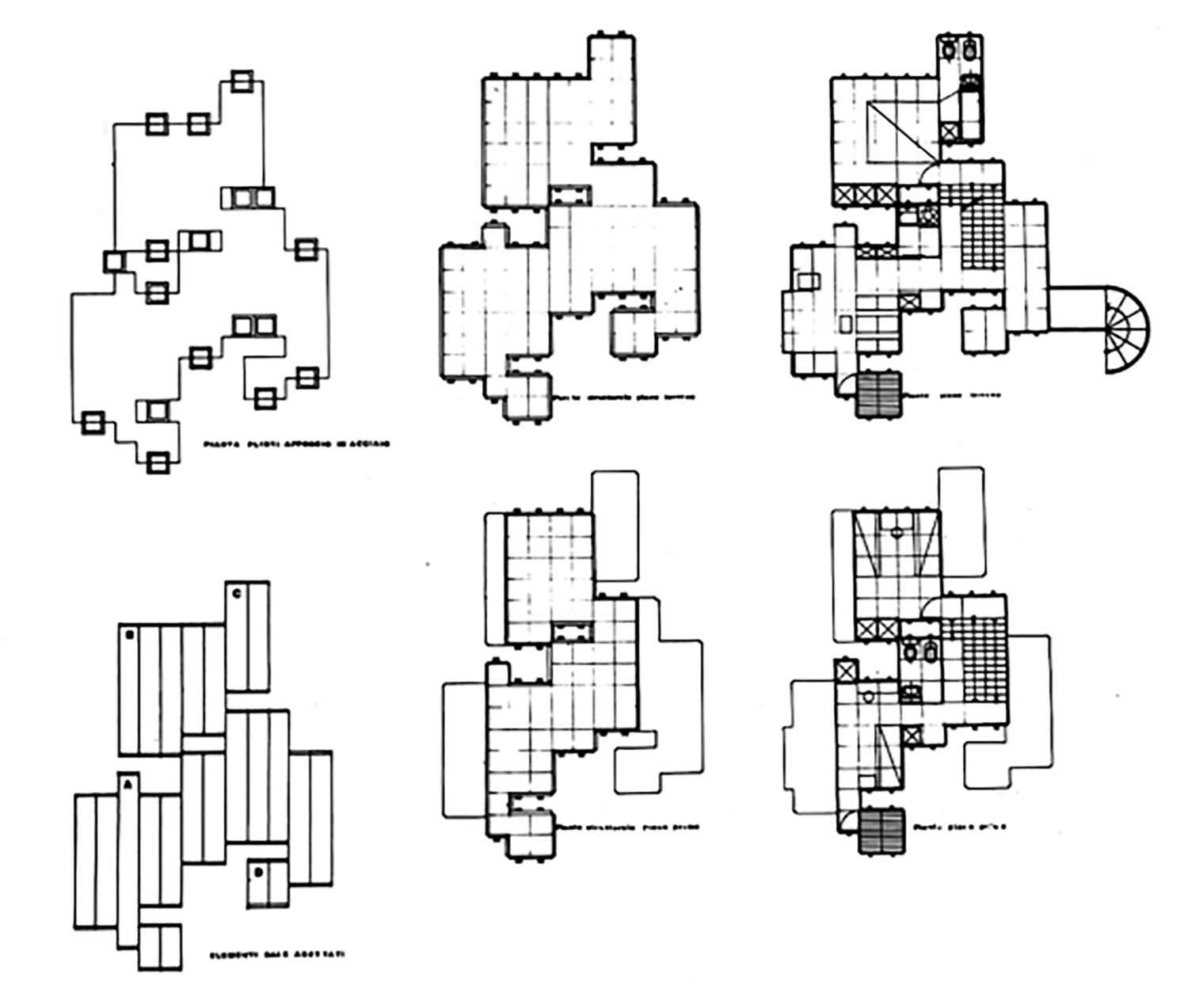
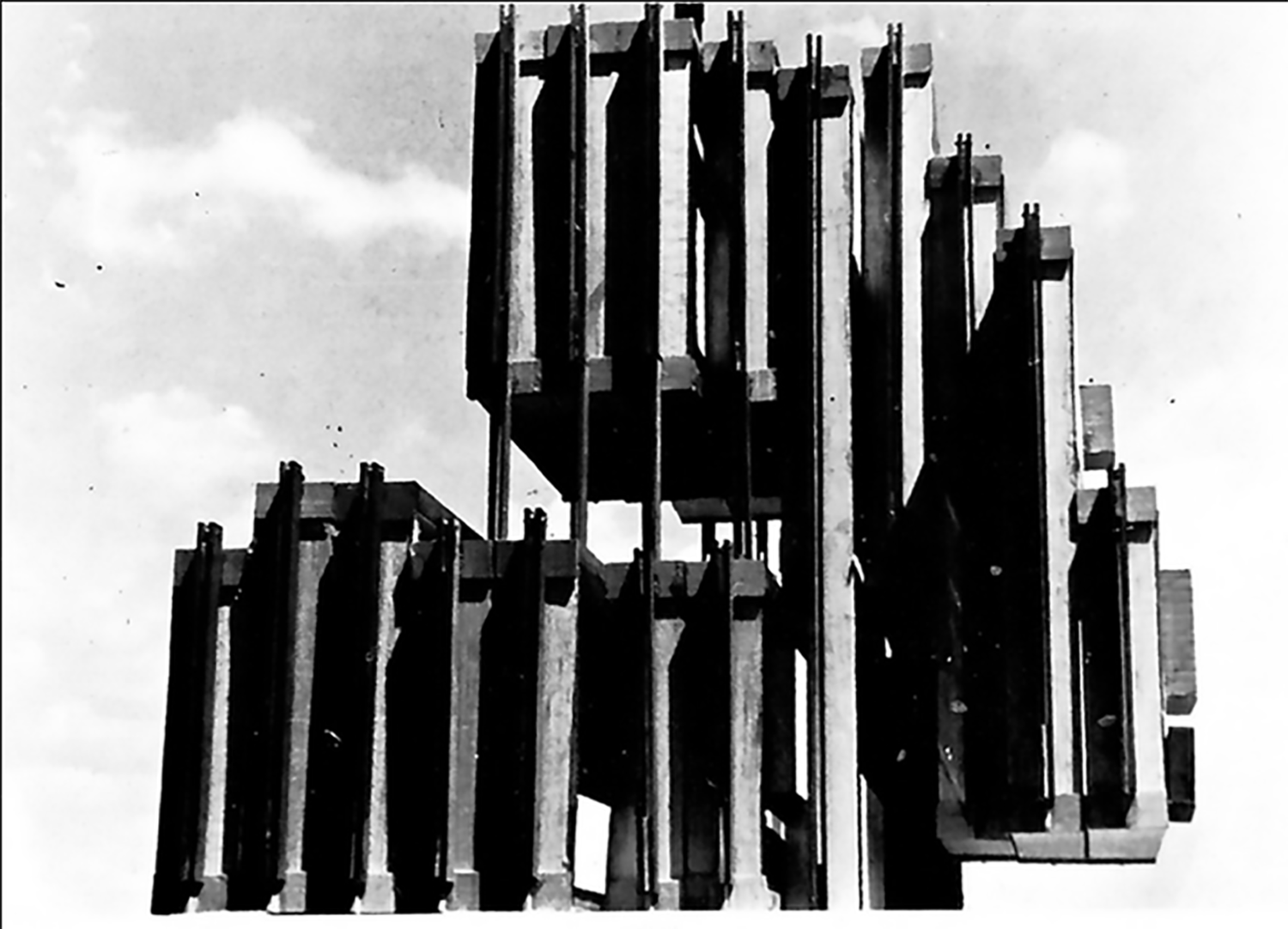
Model view of the 600mm elements bolted side by side to create hte elevation of the buidling.
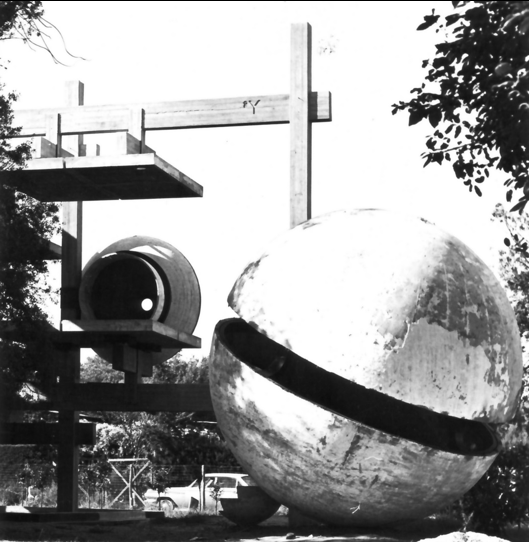
The Sphere next to the main house represents an entirely different concept of living. A micro house contained within a 5m diameter concrete shell.
To create the sphere the Perugini used the same method they tested for the creation of the bathroom shells. The shape of the half-sphere was hollowed out in the sand next to the site. A wooden scribe was used to even the sides and using a plaster the shape was defined.
Then using a second scribe slightly smaller the concrete was spread evenly around the mould. A mesh reinforcement embedded in the cast.
The centre of the scribe can still be seen in the azimuth of the spehere.
After completion, the whole shell was extracted with a pulley system and placed on site.
The second half was then cast into the mould. This second half-shell was mounted on top of a separating ring structure onto the first shell. This ring now contains a perspex transparent strip.
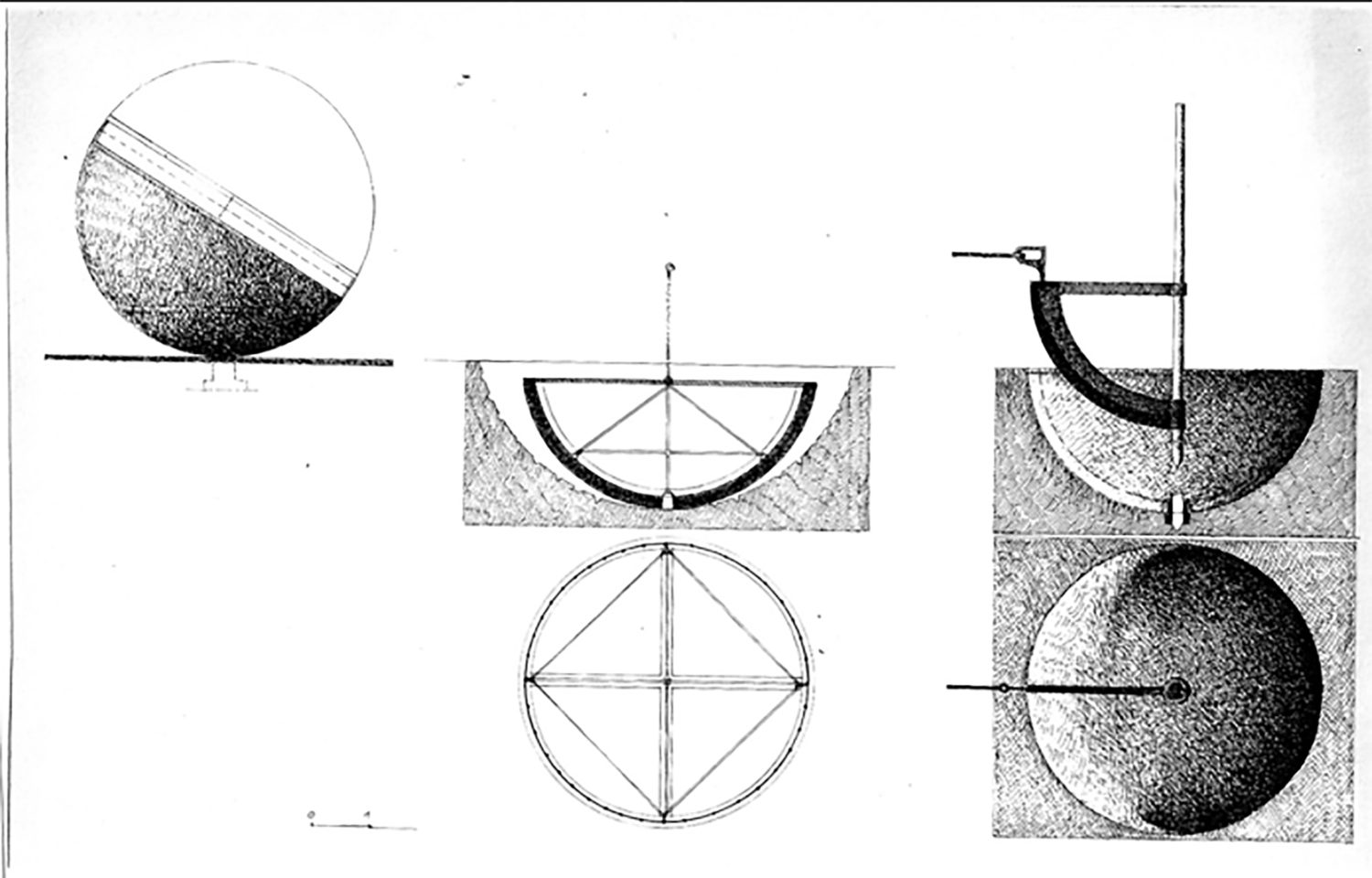
Sketch by Perugini showing how the half spheres were cast into the ground.
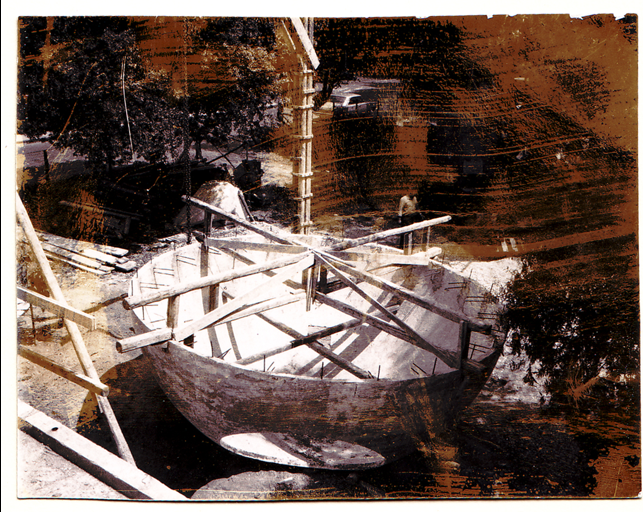
The first bottom shell after it has been extracted from the mould. The wooden support stabilised the fragile concrete shell during the extraction and mounting process.
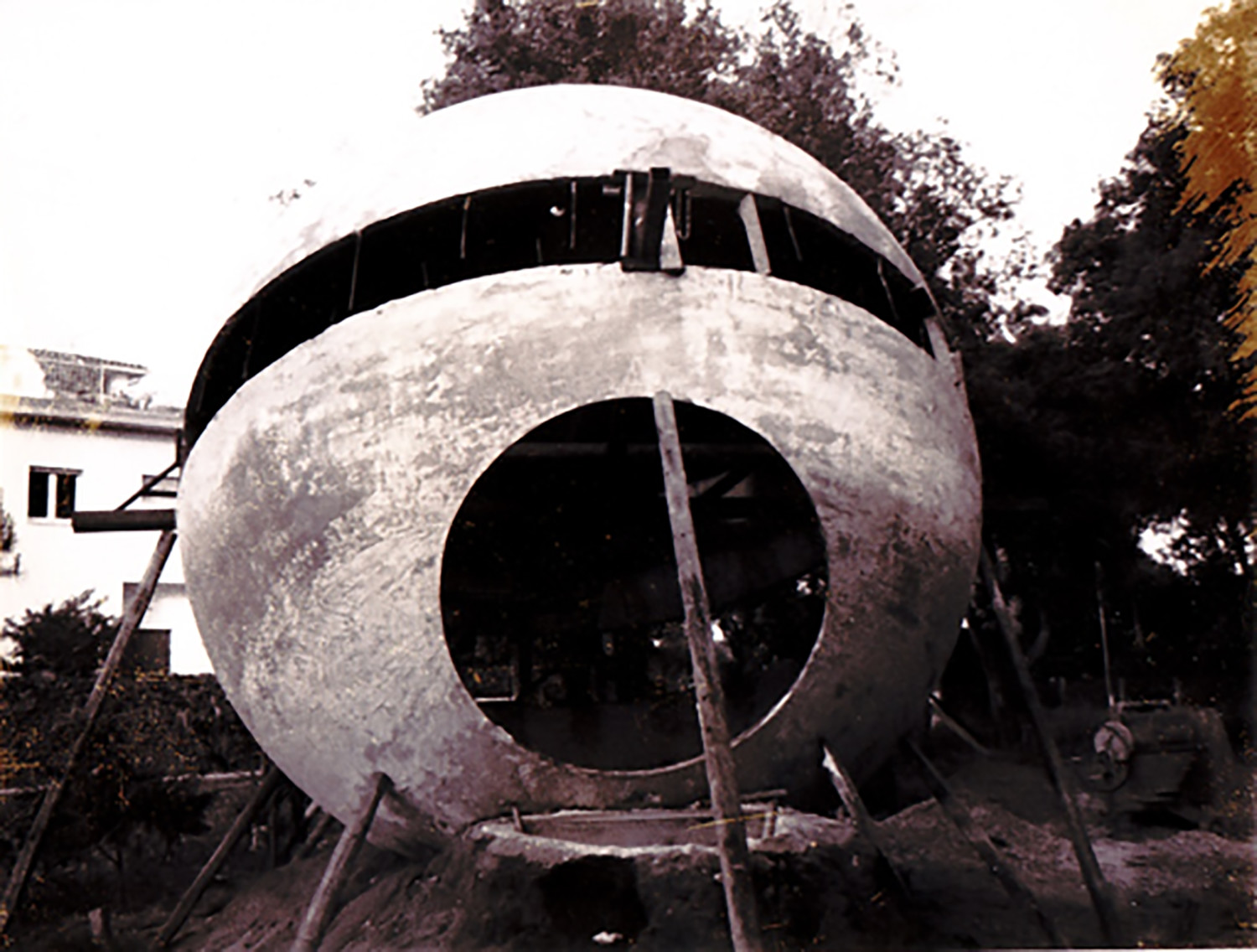
The top shell placed on the bottom half shell.
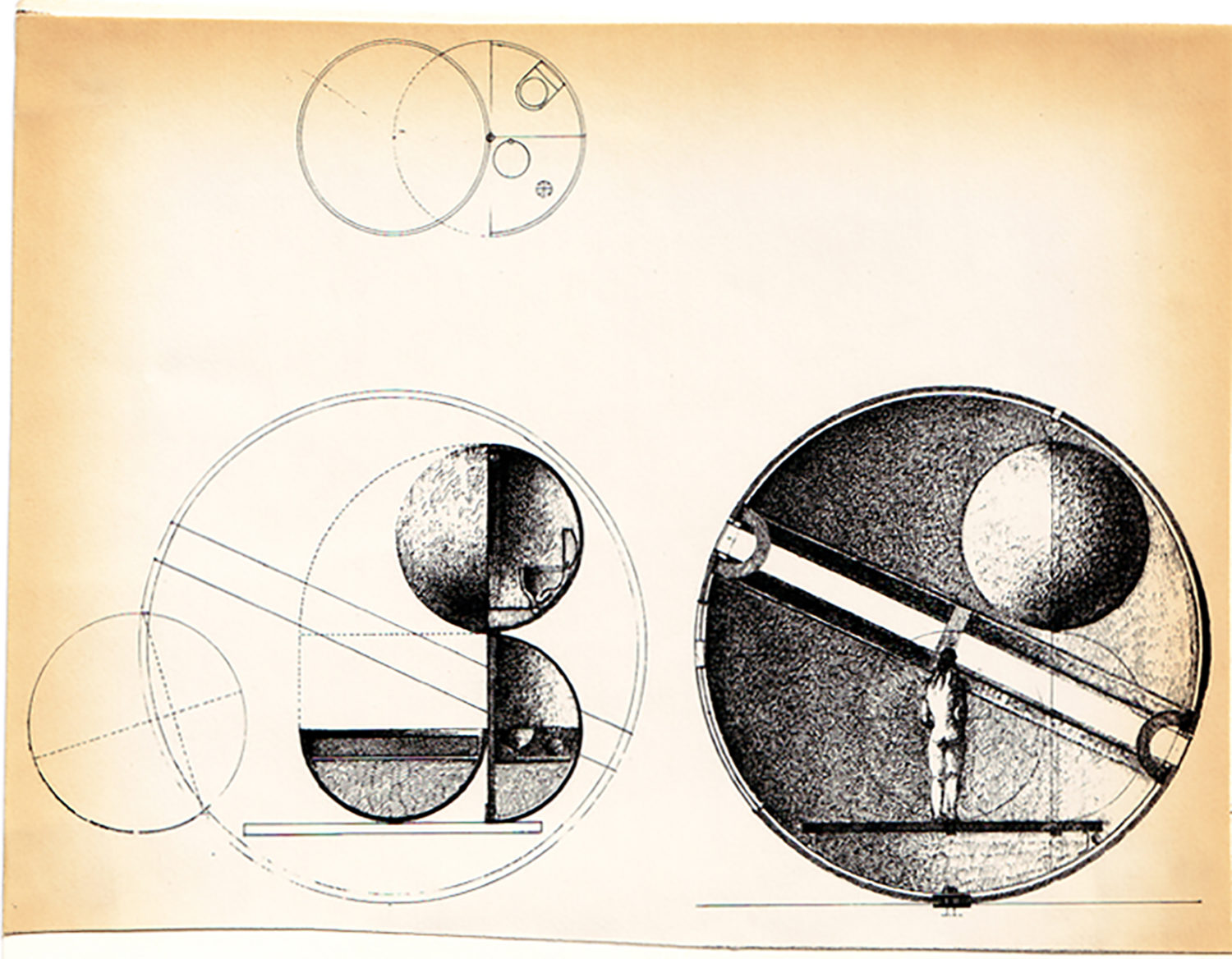
This drawing shows how the Peruginis planned to fit out the sphere. A suspended globe contained the bathroom and the bottom globe could be unfolded to form the bed.
(Al images copyright by the Perugini family archive. )
In hos book Casa Albero, Giuseppe Perugini writes this about the construction and the functions of the Sphere:
THE CONSTRUCTION OF THE BALL AND THE SERVICES
The inspiring principle of their construction is the system of potters. In fact, the first step is to carry out an excavation aimed at obtaining the space to make the initial mind the guiding form, which is also facilitated here by the sandy soil. A vertical pole is then fixed in the center with a welded iron sheet suitably shaped so that, by rotation, the desired shape can be obtained. After a first rotation of the shaped rod, which regulates the excavation, always rotating, plaster is thrown which, depositing itself on the walls, thickens and creates the real counter form. Then we proceed with the installation of a steel reinforcement made separately and fix a galvanized iron circle on the upper part of the resulting form. At this point the initial foil is replaced with one of reduced dimensions, determined by the thickness that is intended to be given to the element to be made and then the concrete is cast by still rotating the rod on itself until the cement has purchased a certain consistency. After the time necessary for the setting of the cement, it is necessary to dig around the counter form that is pining, thus releasing a perfectly finished object which is then removed with the crane and moved for laying. It is a substantially very simple system which, as in this case and if the conditions exist, it can also be carried out on site. The two half-caps that make up the Ball were also made in the same way but with further precautions. In fact, after having made the two parts that they constitute it, a particular COSTITU support structure was made up of a series of “U” beams – suitably pie gates – and large C in galvanized metal, while, as we have said, the choice to tilt the glass junction point made it possible to avoid a sense of static nature that a horizontal solution would have generated. The structure of the house and the ball under construction Scheme of the construction technique of the services and the ball.
Given the purposes that these short notes propose and the small space available, I think I will not have to go any further by recalling here the purposes and the “old-fashioned” method of the treaties whose purpose was to allow the dissemination of ideas, elements and their explanation. I understand perfectly well that Casa Albero can appear at first sight as an object in its own way eccentric, like the dream of a visionary architect, but I hope that whoever reads these lines will recognize its true meaning, its true role, which it is that of “mo of the experimental”, finding in the compositional choices made the concretization of all those values, even symbolic or unconscious, which have always been part of the very idea of Architecture.”
Giuseppe Perugini, Casa Albero
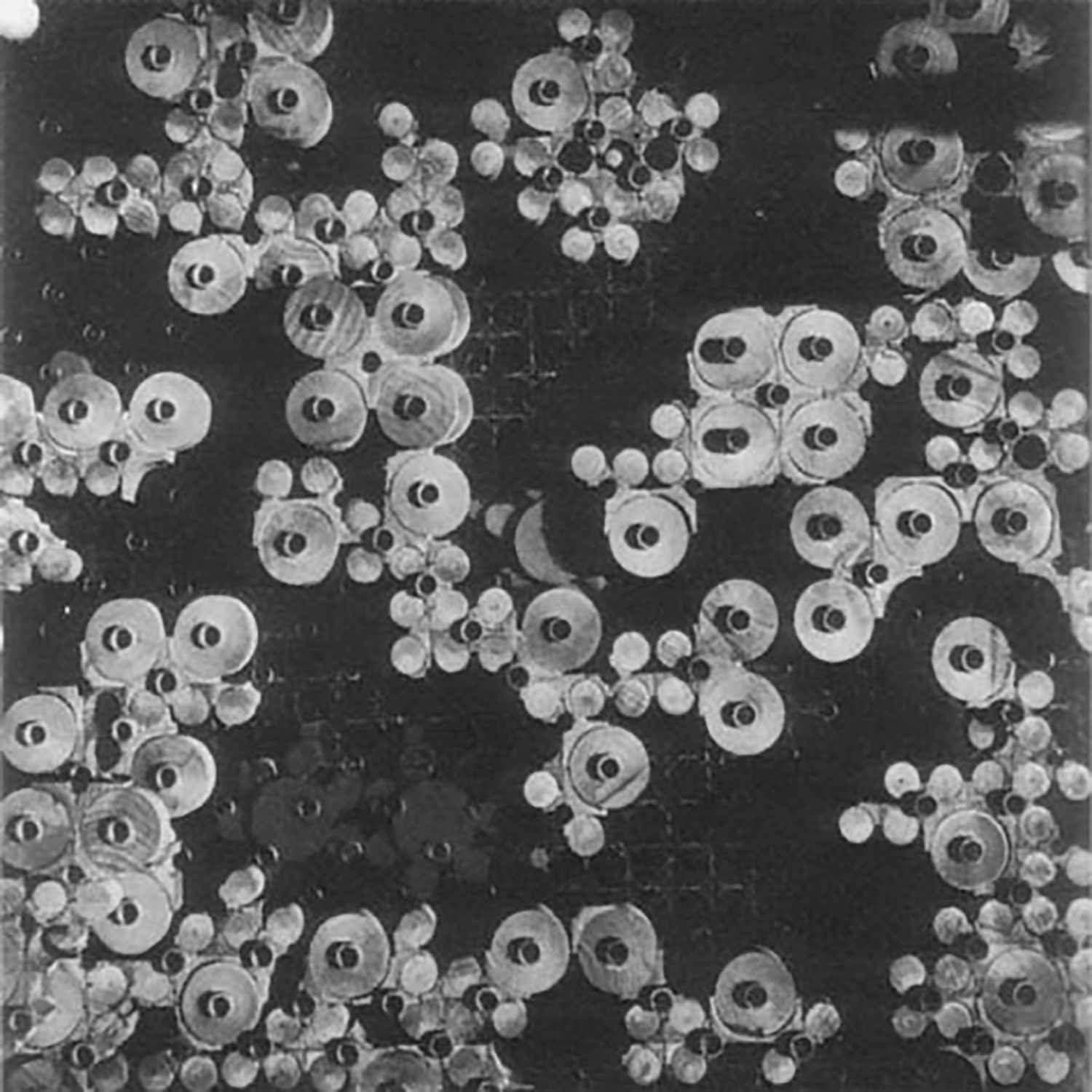
1968 Perugini designed the cybernetic hospital in Pietralata, Rome.
Since 1966 Perugini has developed an interest in the idea of integrating computational processing into architecture. Research by the Russian scientist Victor Glushkov became know at Sapienza Unversity along with groundbreaking advances in cybernetics led by Vittoria Somenzi (1918-2003) and Roberto Cordeschi (1946-2014). Glushkovs book Encyclopedia of Cybernetics had been available in Sapienza since 1967.

For Perugini computers were useful tools for the organisation of complex tasks – following the French word for computer – ‘Ordinateur’ from latin; ‘the one who orders’.
The new vision of the hospital was of a dynamic structure. Spaces were not static, they moved and reorganised themselves around the patients i nthe wards depending on their specific individual needs.
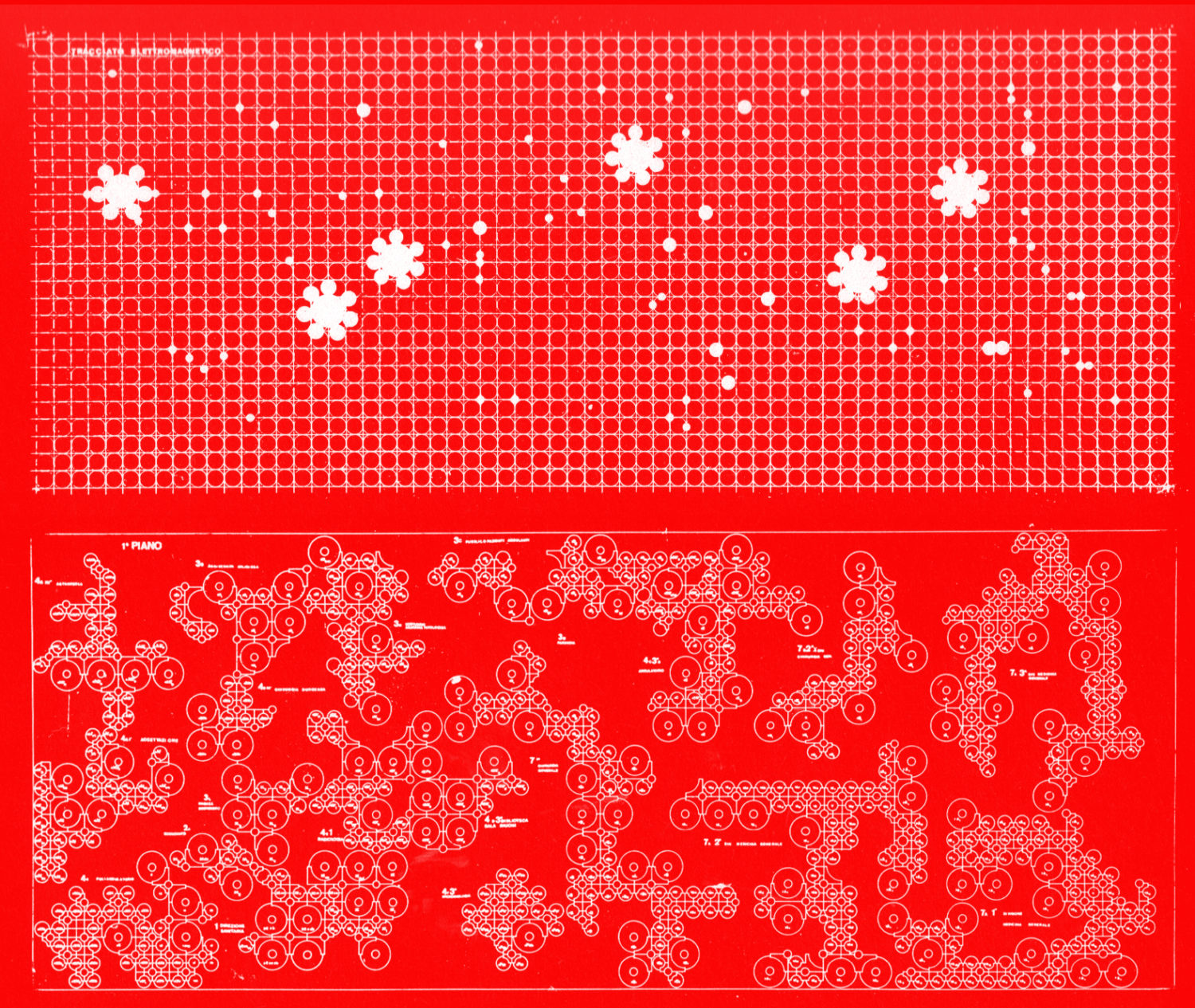
The diagrams of the hospital illustrate the ideas of electromagnetic plates that allow spaces to be moved automatically with ease, controlled by a computational brain. Following Glushkov’s ideas for a centralised control system for the USSR, Perugini designed an open system of circular standardised elements.

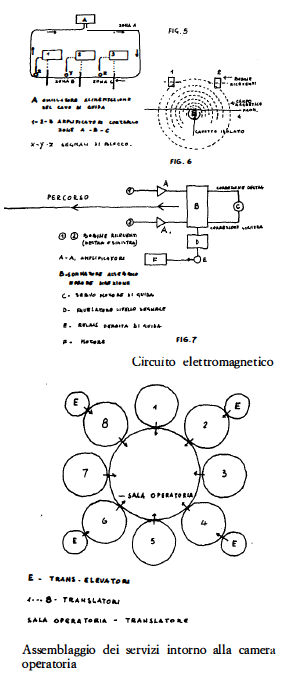
Ospedale cibernetico, The Cybernetic Hospital, 1967
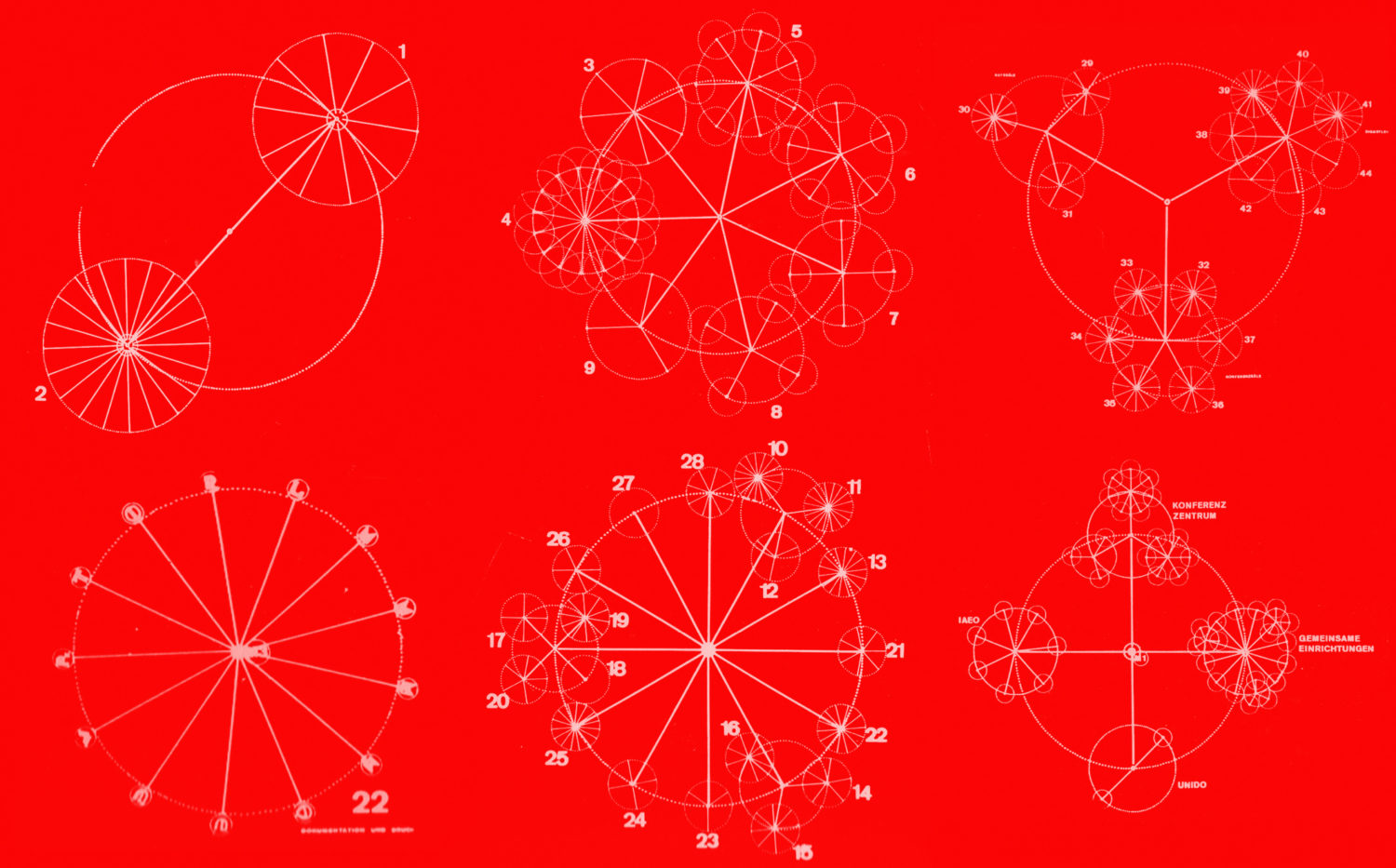
Diagram showing the spatial dependency of the elements in the cybernetic hospital.

The project for the bridge across the Strait of Messina was to connect Calabria with Sicily. The idea was not just to ‘connect’ the two places, it was to create a continuous territory. Perugini chose not to just connect the two sides with a linear connection. It was to create a suspended circular structure with a diameter of 3200 meters.

Suspended 80 meters above the water surface the whole structure consisted of a 70m diameter tubular ring beam. Running along this beam were a railway and highway lanes.
Following Perugni’s interest in computers he envisioned the whole structure to be electronically controlled – shock absorbers woudl dampen the vibrations caused by the wind and the constant tremors of frequent earthquakes in the region.
Containers that woudl move on electromagnetic tracks woudl run along parts of the upper beams and transport people, goods and ‘various equipment’ from side to side.
Perugini sees the structure as ” … a city of services with extreme mobility, whose standards are chaotically located without any organic reference.” (p174).
He continues to describe the technical features:
-theoretical calculation scheme of considerable simplicity (even isostatic for perimetric loads and for symmetric accidental loads);
– section of constant height (70 meters) also in correspondence with the supports (thus avoiding the considerable heights absolutely necessary in the piles of the suspended bridges for relaunching the cables).
– minimum surface exposed to wind actions and complete absence of those phenomena of aerodynamic instability typical of suspension bridges;
– almost total absence of stress states produced by thermal variations from shrinkage phenomena thanks to the particular system of “oscillating supports” provided between the steel structure 10 and the semicircular hollow reinforced concrete structure of the supports;
– ease of adaptation without consequences for any seismic shocks or waves which are always due to the “oscillating supports” mentioned above. (p179)




All images from the Perugini archive
Interview with Raynaldo Perugini in the Maxxi museum in Rome.
Perugini published this text describing the context of the bridge in 1975:
Bridge on the Strait of Messina
Giuseppe Perugini, Progetti e Ricerca, 1975, p169+
«… This is the function of the Perugini project, it is not limited to the solution of the bridge but it studies in depth the arrangement of the territory of the two banks and tries to create a work that is not only the continuation of the highways or the railway line but something more lively, because the work embodies the elements to ensure that in the large suspended circle there is room for commercial activities of various appeal: public places, hotels, etc.
let us try to take a look that detaches itself from the often very limited views of a present, which conditions us, and we look once more!
Messina, most of the times, has even struggled to keep up with the times, especially in recent decades; in fact, the city of the past managed to obtain certain structures and certain elements that qualified it and placed it in the right historical moment, also giving it a valid economic presence, see Messina di Juvara and Palazzata. We are now a fairly delicate and important moment for the history of this city and it is perhaps more for men than ever, for the truest people from Messina, to be able to see now what the future that is being prepared will be. It is not only necessary to think that what is currently a simple need of connection between two territories also becomes the solution to the negative facts that take place within them: a serious analysis must be done, an analysis that keeps in mind the pros and cons that are the basis of this or that choice. You have to notice the economic significance that Messina and its province have. Today Messina bases its economy on the principle of self-sufficiency: the entire social apparatus thrives on trade, “service” and bureaucratic structure. The few industries in the area. municipal have a very limited employment index and their market runs out in the same provincial or even municipal area. The same goes for tourism: the Lido di Mortella and the two lakes of Faro and Ganzirri serve as an outlet and a reference only in the municipal area. The industrial reflection of some centers of the province and of the industrial center of Catania is affected only to a small extent also because of the precarious conditions of the current road system. The only activity that has a certain employment index and which almost gives the city its face is the ferry with those few infrastructures connected to it ».
“What is the beauty of Messina is a fact that comes from what it was since it was chosen by the Greeks precisely for its enchanting position for the wonder of its natural port that stretches safely to embrace the sea of the Strait, unique for the changeability of its coasts, splendid for the spectacle of the whole.
After the completion of the motorway network, the greater speed of travel of the vehicles will reduce the distances between the most emerging poles in the territory, favouring the great industries of the North in selling their products to the detriment of the emerging Sicilian initiatives. In a nutshell the bridge would function as a buffer between the industrialized poles of Sicily and the northern industries: Messina and Reggio would also lose their appearance as “doors” and sorting yards.
The bridge is nothing more than a design element in the field of transport; but transport is only an aspect of urban planning.
If you want to create an effective and non-univocal connection between Sicily and the continent, a connection that is within a Messina-Reggio Calabria conurbation and tourist attraction centre: you must create a complex and complete structure on the Strait; this structure must act as a reference, not a reference for a record obtained with an engineering technique, it is well known that the records precisely because they are fragile because they can be beaten, but a reference due to the activity of the structure that we are proposing. The realization of such a work must then have upstream a planning basis at an urban level in clear connection with the intrinsic activities of the structure, a structure capable of acting as an archetype of a territorial reunification process and as an “equipped axis” with the capacity to fulfill and at the same time overcome the concept of connection, to recover the essential values of this great enterprise and to satisfy all levels of need; perhaps even to propose new meeting points ».
«From a seismic point of view, the area of the Strait, at least in depth, is extremely complex: a large seismic fault starts roughly from the Aeolian Islands, crosses · the mirror in depth and continues towards the Ionian. There is a continuous presence of tremors (vibrations more or less accentuated according to the geophysical phenomena).
From a water point of view, given the enormous • variety and speed of the currents, vortices are generated also due to the transfer of water from the Tyrrhenian to the Ionian Sea, which, rising from depths that are around 150-200 meters, exceeding the saddle on 90 meters, they rush to the other side with accentuated speed.
The speed of the currents reaches about 2.6 meters per second. These currents, which are also found in depth, reverse direction every six hours or so causing upheavals.
The wind creates abnormal and complex conditions. Measuring the wind, on the Strait of Messina, is very difficult because the mass of air has within itself equally unpredictable layers of pressure and depression.
The geological investigation has allowed to find on both the Sicilian and Calabrian sides, recent floods overlying tertiary formations in stratified form with altered granite below.
On the Calabrian shore, the crystalline basement is located at a lower depth, 100-150 meters, while on the Sicilian shore the sedimentary soils have a considerably greater thickness – 300 meters. Neither center of the Strait, the crystalline basement is located about 300-600 meters below sea level. The time limits of the passage in the strait (3 km), the two hours needed, are equivalent to about 200 km of highway.
The last decade has seen three major bridges suspended in Europe. For the first time, these bridges were built outside the United States of America. The first was the “Forth Road Bridge” near Edinburgh in Scotland, completed in 1964; they followed the Tagus Bridge in Lisbon, opened in 1966 and the bridge across the Severn linking England to Wales built in 1966. All these bridges have arches of about 1000 meters. The 1074m high bridge is currently under construction Bosphorus which will connect Europe with Asia.
A suspension bridge of 1400m will be built on the Humber estuary near the town of Hull.
Arches of 3000 meters and more are possible and economically viable in certain circumstances ».

Competition for the Centre of Contempory Art, Centre Baubourg in Paris.
International competition with O.C. Cacoub, R. Heim de Balsac, G.G. de Rossi, Raynaldo Perugini and Y. Roa.
1971/1972 Giuseppe Perugini together with the French architect Olivier Clement Cacoub, R. Heim de Balsac, G.G. de Rossi, Y. Roa and his son Raynaldo Perugini, entered the international design competition for the design of the new museum at the Plateau de Beaubourg in Paris.
The competion attracted 681 competitors from 49 different countries and was ultimatly won by Renzo Piano and Richard Rogers.
Perugini and his collaborators entered a scheme which consisted of a dynamic structure modelled in metal. Four cylindrical towers held the circulation and the artwork on show.
Inspired by his research into the cybernetic architecture Perugini envisioned a flexible structure where each visitor would be able to select a number of pieces they wanted to show and the building would dynamically reconfigure and regroup itself to create a unique experience for each of the visitors.
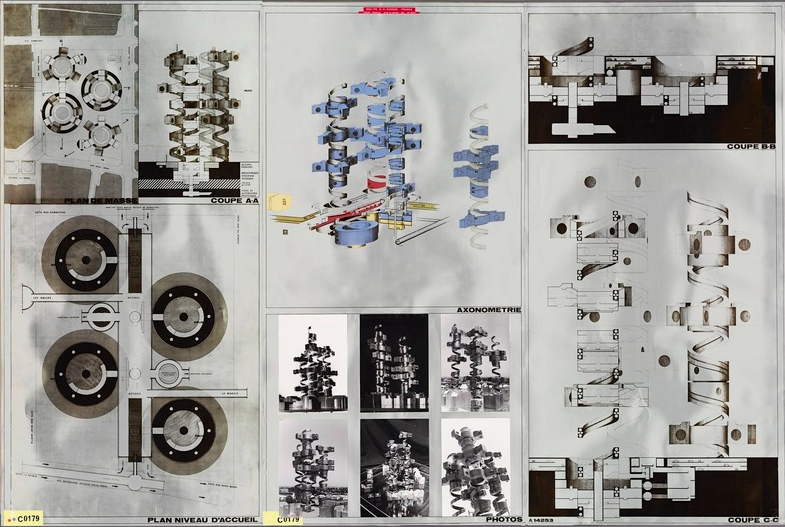
Competition entry for the Palais Beaubourg, now in the arhcive ofthe Centre Pompidou, Paris. LINK
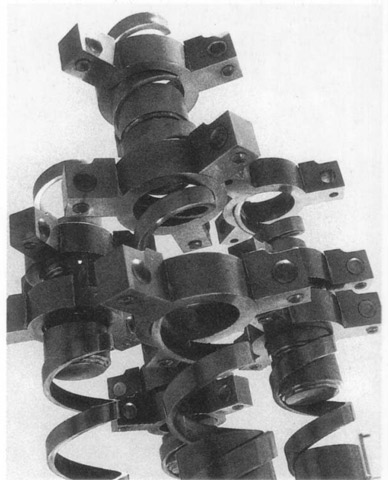
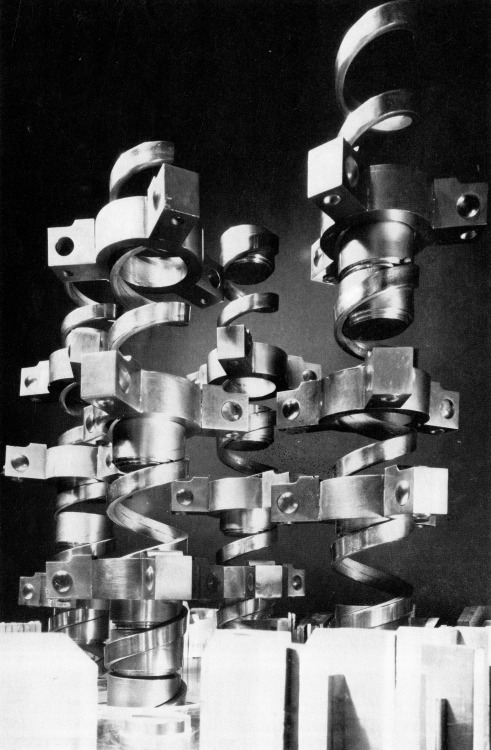

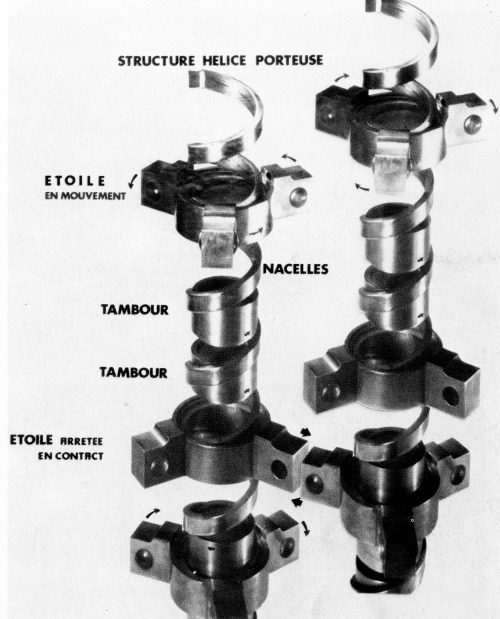

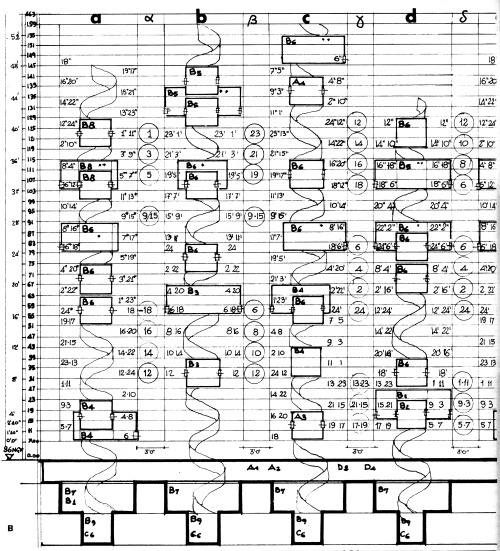

Published: L’Architecture d’Aujourd’hui / “Recherches Matériaux”, No.160, février-mars 1972, pp. 88-91
Centre Pompidou / Palais Beaubourg, Paris

1963 the Italian goverment decided to build a residental district of about 9000 flats on an area of 44 hectars in the area of Tre Fontane.
